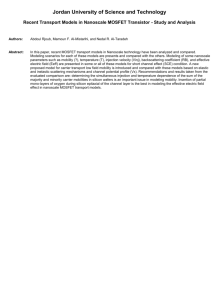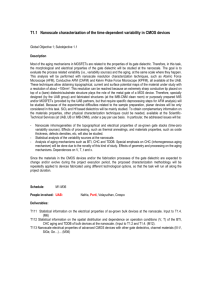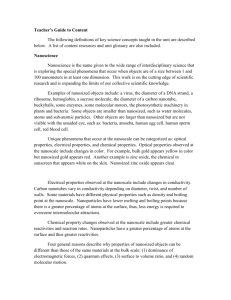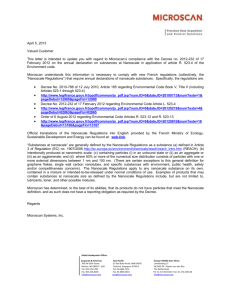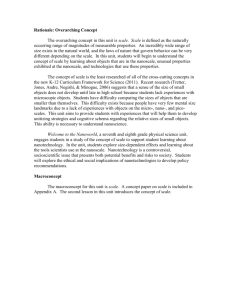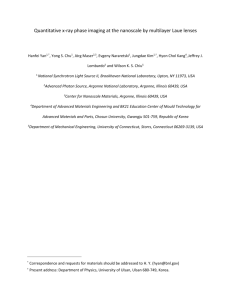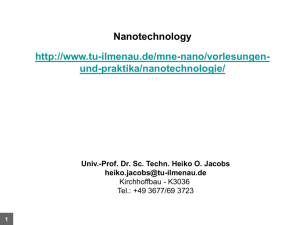Nanoscience Lesson Plan 5_12
advertisement
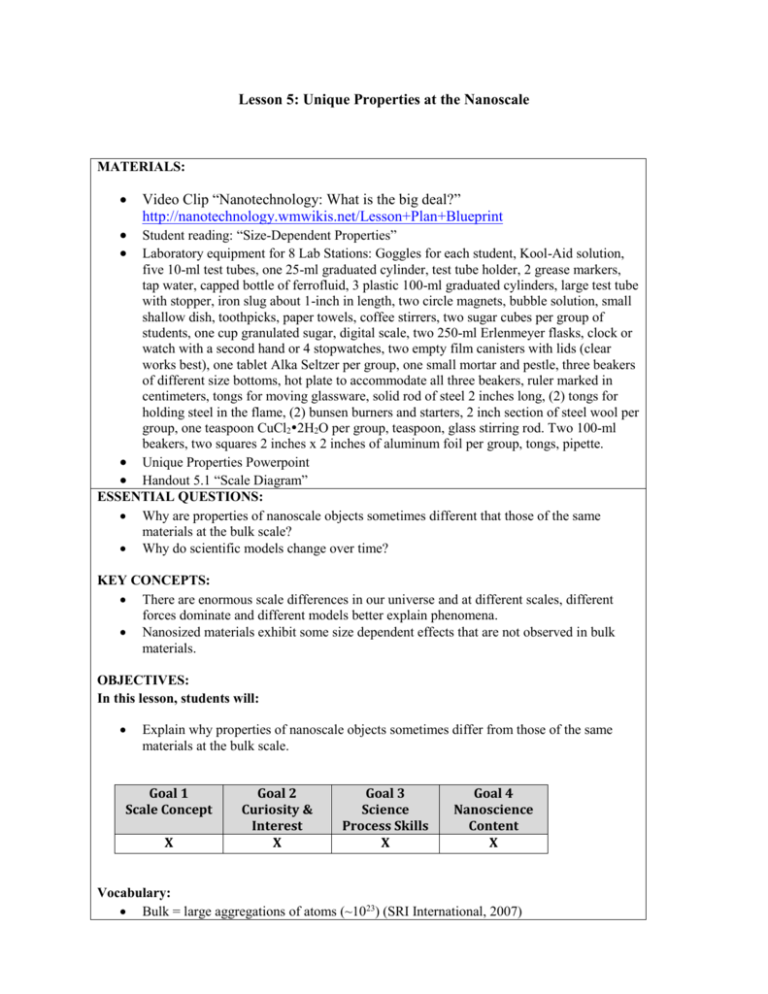
Lesson 5: Unique Properties at the Nanoscale MATERIALS: Video Clip “Nanotechnology: What is the big deal?” http://nanotechnology.wmwikis.net/Lesson+Plan+Blueprint Student reading: “Size-Dependent Properties” Laboratory equipment for 8 Lab Stations: Goggles for each student, Kool-Aid solution, five 10-ml test tubes, one 25-ml graduated cylinder, test tube holder, 2 grease markers, tap water, capped bottle of ferrofluid, 3 plastic 100-ml graduated cylinders, large test tube with stopper, iron slug about 1-inch in length, two circle magnets, bubble solution, small shallow dish, toothpicks, paper towels, coffee stirrers, two sugar cubes per group of students, one cup granulated sugar, digital scale, two 250-ml Erlenmeyer flasks, clock or watch with a second hand or 4 stopwatches, two empty film canisters with lids (clear works best), one tablet Alka Seltzer per group, one small mortar and pestle, three beakers of different size bottoms, hot plate to accommodate all three beakers, ruler marked in centimeters, tongs for moving glassware, solid rod of steel 2 inches long, (2) tongs for holding steel in the flame, (2) bunsen burners and starters, 2 inch section of steel wool per group, one teaspoon CuCl22H2O per group, teaspoon, glass stirring rod. Two 100-ml beakers, two squares 2 inches x 2 inches of aluminum foil per group, tongs, pipette. Unique Properties Powerpoint Handout 5.1 “Scale Diagram” ESSENTIAL QUESTIONS: Why are properties of nanoscale objects sometimes different that those of the same materials at the bulk scale? Why do scientific models change over time? KEY CONCEPTS: There are enormous scale differences in our universe and at different scales, different forces dominate and different models better explain phenomena. Nanosized materials exhibit some size dependent effects that are not observed in bulk materials. OBJECTIVES: In this lesson, students will: Explain why properties of nanoscale objects sometimes differ from those of the same materials at the bulk scale. Goal 1 Scale Concept X Goal 2 Curiosity & Interest X Goal 3 Science Process Skills X Goal 4 Nanoscience Content X Vocabulary: Bulk = large aggregations of atoms (~1023) (SRI International, 2007) PROCEDURES: TEACHER NOTES: Introduction/Hook: This lesson will take 2-3 class periods. The 8 lab stations are set up for students to participate in mini experiments. At most of the stations, only limited directions have been provided to encourage students to design their own simple procedures and practice science process/inquiry skills. Show video clip “Nanotechnology: What’s the big deal?” (3:11) You probably already know that materials have physical and chemical properties that can be used to distinguish one material from another. However, when the size of some materials gets very small, these properties can change drastically. What is special about the nanoscale? What properties can change with scale? Why do small particles behave differently than large ones? Students will go to each lab station, make observations and answer questions. (See Lab Directions and Handouts.) Debriefing: After the stations have been completed the class will compare their findings. Inductive reasoning will be used to generalize the findings of the 8 activities. Analytical reasoning will be used to create explanations for why these effects occur. Students will create a graphic organizer or other method to display their findings from all 8 activities. From these generalizations, can you think of any explanation why this occurs? For example, why would smaller objects react faster? Give students a few minutes of wait time. For example, several of the activities compared small particles to larger particles. Generalizations should include: 1) When particles are smaller, reactions happen faster. 2) Some things in nature assemble themselves (bubble experiment). 3) When particles are smaller, they may appear colorless. Guide students the idea that as objects get smaller, a larger fraction of atoms are on the surface and a smaller fraction are on the interior. This is called surface area to volume ratio and is an important idea at the nanoscale. In the lab experiments, we saw that when we increased the surface area, reactions occurred faster. What properties changed when particles got smaller? Why do you think the properties changed? Properties that changed include: color, odor, and reactivity. The reason for property changes should include: more surface area for amount of volume. After discussion of the experiments is completed, review the unique properties that occur at the nanoscale using the Unique Properties Power Point. Engage students in discussion. Give each student a copy of the Scale diagram (Handout 5.1). Take a few minutes to look over this diagram. Jot down your answers to the following questions: 1) Why is the nanoscale so different than the microscale and macroscale? 2) Why must quantum mechanics be used in the nanoscale? 3) Why is gravity less important than electromagnetic forces at the nanoscale? 4) Why can’t we see nanoscale objects with a microscope? Grouping: There are 8 lab stations. Students should work in groups of no more than 2 or 3. Whole class for debrief and discussion. Homework: Read “Size Dependant Properties” Differentiation for: ELL Twice-Exceptional; Highly Gifted; Alternate experiment options for highly gifted students (see resources list). Differentiation: Choice: Resources: Products: Tiered questions/assignments: Answers: 1) Surface area to volume ratio is much larger, quantum effects become significant, gravity becomes negligible and is dominated by electromagnetic forces, and random molecular motion becomes more important. 2) The laws of classical mechanics do not work at extremely small sizes. 3) Atoms have lots of charges (electrons and protons) but very little mass.

